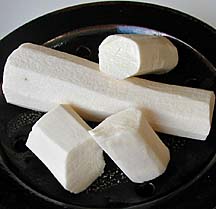
Eleanor Nakama-Mitsunaga
![]()
|
This potato-like starch is probably best known for its byproduct, tapioca. Although we consume more taro and potatoes in the islands, the cassava root is a healthy starch that should be considered.
The basics: Cassava is native to South America -- or more specifically, Brazil. The shrub-like plant bears large, elongated tubers, called cassava, yuca or tapioca. The starch is a staple in South America, the Caribbean, Africa and many parts of Asia, where it is commonly dried and milled into flour.
The tuber grows to an average length of 8 to 12 inches and a diameter of 2 to 3 inches. It resembles a sweet potato, but with a distinctive dark brown, bark-like skin. The cassava root may also be covered with a white, waxy sap.
The flesh is pure white, hard and dense, turning softly fibrous and translucent when cooked. The texture is chewy and tapioca-like with a sweet, buttery flavor. Cassava is said to be a good source of iron.
Selecting: Choose roots that are heavy for their size with shiny skin. Watch out for any sour odor, soft spots, cracks or mold on the root.
Storing: Store cassava in a cool, dry area on the counter or place in the refrigerator for no more than two or three days. Cassava will rot quickly and should be used as soon as possible. After cooking it can be stored in the refrigerator for a day or two, or frozen for a couple of months.
Use: Wash skin thoroughly, then cut the root into sections. Use a paring knife to tear off the underskin and bark-like outer skin. Like potatoes, cassava will discolor quickly, so place in a bowl of water until ready to cook.
The root can be simply boiled and used in the same manner as potatoes. It can also be sautéed, fried, deep-fried or stewed. Cassava is often used to make fritters and chips or as an addition to soups and stews.
In Asian cuisine, cassava is more often referred to as tapioca and used in desserts such as cakes and puddings. Dried cassava is milled to make tapioca flour, which is used to make the popular tapioca pearls.
Where to buy: Cassava root is sporadically available year-round at Asian markets and in Chinatown. Some supermarkets, such as Foodland, often carry cassava on a limited basis as well. Frozen whole and grated cassava are also available in Asian markets that cater to Filipino ingredients. Prices for the root run $2 to $3 a pound.
Eleanor Nakama-Mitsunaga is
a free-lance food writer. Contact her
online through features@starbulletin.com


